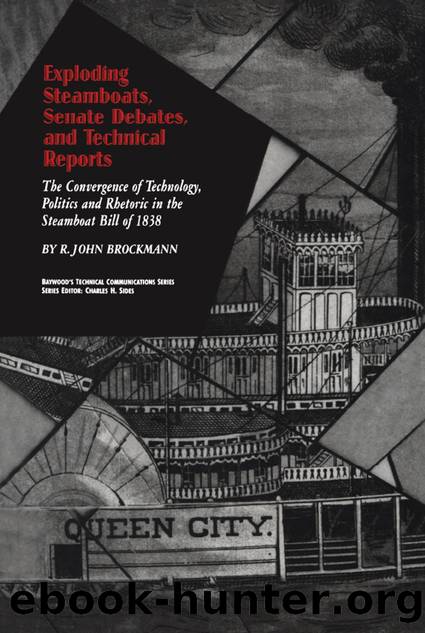Exploding Steamboats, Senate Debates, and Technical Reports by Brockmann R. John;

Author:Brockmann, R. John;
Language: eng
Format: epub
Publisher: Taylor & Francis Group
Report of the Committee of the Franklin Institute of the State of Pennsylvania for the Promotion of the Mechanic Arts, on the Explosions of Steam-Boilers Made at the Request of the Treasury Department of the United States, Part II, Containing the Report of the Sub-Committee to Whom Was Referred the Examination of the Strength of Materials Employed in the Construction of Steam Boilers (1837)
Johnson was 42 when he presented Part II, Bache was 30 when he presented the General Report. Johnson was Harvard educated, lectured to mechanics at the Institute, and drew his primary salary teaching at the Instituteâs High School [66, pp. 93â113]. Bache entered West Pointâthe premier engineering institution in the United States at that timeâat the age of 15, and, once graduated, became one of its youngest instructors. He moved to Philadelphia where he accepted a professorship at the University of Pennsylvania. The Strength of Materials investigation was Johnsonâs first major investigation, while Bache had preceded his Chairmanship of the steam-boiler project with investigations into water-wheels, weights and measures, and meteorology. Bear these differences in mind because the rhetoric and approach of Johnson and Bache clearly put them at odds with each other, caused friction that was determined by an ultimatum being issued by the Institute to Johnson to finish his work, and could only be worked out by making Bache and Johnson each Chair of their particular subcommittees.
Walter Johnson (see Figure 23) first made his written appearance in the steamboat reports in the longest report in Report 478, an account of 42 pages of some 173 different experiments with most of the results presented in 16 tables, some of which extend over two and three pages. Primarily, Johnson was doing âbasicâ research in attempting to develop a law of âaction between a heated surface and water at different temperaturesâ [57, p. 125], but he introduced this only generally in the opening to his section of Report 478 where he stated rather generally that he wanted to find out the relationships between
1. Quantity of steam produced;
2. Weight of material;
3. Surface exposed;
4. Time of action; and
5. Period of greatest effect.
Johnson nicely applied his experimental results initiated in a very general way to six specific points:
1. The temperature of most rapid vaporization;
2. The name of the phenomena exhibited at that point and immediately above and below it;
3. Effects of lubricating the surface;
4. Influence of mechanical pressure to bring liquid in contact with hot metal;
5. Action of hot metals on other liquids; and
6. Nature of repulsion and degree to which heat is transferred from metal to liquid.
Yet Johnsonâs conclusions appeared to have little application to legislation and practice, and thus his section was unique in a report which primarily conveyed very practical observation and opinion. Additionally, he weakened the ability of readers to connect his basic research to steamboat legislation by concluding with a long description of his experimental apparatus.
This example of Johnsonâs rhetorical approach to report writing in Report 478 is quite similar to his approach to Part II
Download
This site does not store any files on its server. We only index and link to content provided by other sites. Please contact the content providers to delete copyright contents if any and email us, we'll remove relevant links or contents immediately.
Asking the Right Questions: A Guide to Critical Thinking by M. Neil Browne & Stuart M. Keeley(5334)
Autoboyography by Christina Lauren(5075)
Dialogue by Robert McKee(4144)
Eat That Frog! by Brian Tracy(4126)
Sticky Fingers by Joe Hagan(3894)
Journeys Out of the Body by Robert Monroe(3438)
Annapurna by Maurice Herzog(3278)
Full Circle by Michael Palin(3256)
Elements of Style 2017 by Richard De A'Morelli(3224)
Schaum's Quick Guide to Writing Great Short Stories by Margaret Lucke(3171)
The Art of Dramatic Writing: Its Basis in the Creative Interpretation of Human Motives by Egri Lajos(2840)
The Diviners by Libba Bray(2786)
Why I Write by George Orwell(2757)
The Mental Game of Writing: How to Overcome Obstacles, Stay Creative and Productive, and Free Your Mind for Success by James Scott Bell(2751)
In Patagonia by Bruce Chatwin(2736)
Atlas Obscura by Joshua Foer(2693)
The Fight by Norman Mailer(2671)
Venice by Jan Morris(2412)
The Elements of Style by William Strunk and E. B. White(2365)
